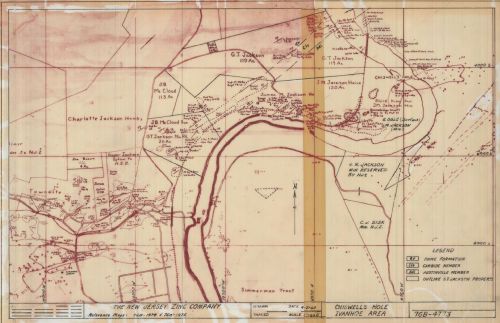One responsibility of Geology and Mineral Resources is to serve as a repository for geologic and mineral resources information relevant to the Commonwealth of Virginia. We have maintained valuable collections of geologic materials since the early 1900s. Our archives include extensive collections of rock, mineral, and fossil specimens, historic photographs, rock thin sections, results of petrographic analyses, geochemical laboratory results, reports on groundwater and mineral springs, historic and out-of-print publications, geophysical well logs, seismic lines, well cuttings, and drill cores.

In grant year 2024, we cleaned and photographed
specimens from Rutherford Mine Collection
Recognizing the need to both preserve these valuable collections and improve the ability of staff and customers to search for, cross-reference, and access the information they contain, we implemented a long range data preservation plan in 2007, initially addressing 17 key collections. Since that time, the number of identified collections has grown to 28, containing well over 100,000 individual items. With support from the U.S. Geological Survey (USGS) National Geological and Geophysical Data Preservation Program (NGGDPP), we began a comprehensive process of inventorying, cataloging and digitizing these collections to be made available to the public. As part of this work the collections were uploaded to a national repository known as the Registry of Scientific Collections.
Current Work
For the 2023-2026 grant cycle, the National Geological and Geophysical Data Preservation Program (NGGDPP) grant will support Geology and Mineral Resources to physically preserve, digitize, and create metadata for approximately 10,000 paper documents, maps, notebooks, reports and images in three collections: Historical Images, Unpublished Geologic Maps, and Field Notebooks. Activities include scanning of slides, photos, documents, maps and notebooks, as well as quality control and creating hyperlinks for all items. We plan to convert two (2) county maps to Level-3 GeMS format. We also plan to georeference our entire unpublished field map collection with a map index available in ArcGIS online. Finally, we plant to revise and improve the metadata previously submitted to ReSciCol for our 27 collections, including hyperlinks for direct public access to items. The requested funds will provide support for a Scientist and Geologic Technician contracted from our temporary staffing provider. Adding items to our collections and providing materials available online will greatly improve discoverability by the public.
In addition, we have received funding to update our current Virginia Geologic Information Catalog. The VGIC is a SQL database with 14 collections stored in discrete tables that are not cross-referenced. Because the collections are not interrelated discoverability is seriously impeded. The requested funds will provide support for hiring a contract database developer from our temporary staffing provider. We plan to create a master index across the collections so information can be found easily. We also plan to add tables for all of the collections that are stored in other formats such as Microsoft Excel and Access. In addition, we plan to have scripts to synchronize the spatial data to ArcGIS geodatabases that are used by our scientists as well as for our ArcGIS online service and our web maps. Improvements to the digital infrastructure will greatly enhances discoverability and accessibility of our data for the public.
Finally, GMR received funding to preserve information that is useful for characterizing and identifying critical minerals resources in Virginia. We propose to submit 200 samples to the USGS for geochemical analyses to determine major, minor, and trace element compositions, including 170 preserved samples from the Rock Repository collection and 30 samples from the Drill Core and Well Cutting Repository collections. The geochemical characterization of these samples will help our scientists evaluate critical mineral potential in Virginia and supplement our existing geochemical datasets. Our second activity will update our geochemical database after receiving the laboratory results and critical minerals website to match the new critical minerals list finalized by the Department of Interior in 2022 (Federal Register 87 FR 10381). Updating our web-based critical minerals information will provide significant value to Virginia Energy's customers, the minerals industry, and scientific researchers.
Access our collections here.

